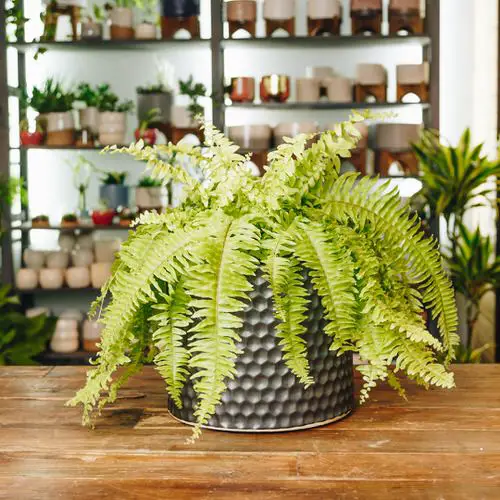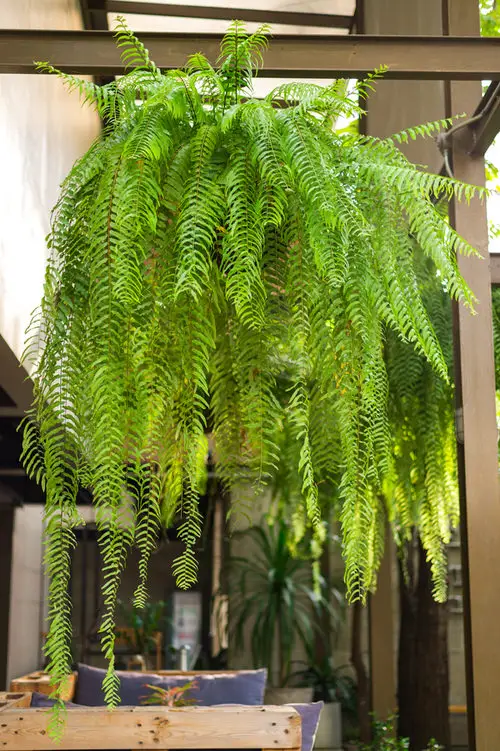Learn everything about How to Grow Boston Fern Indoors and bring tropical vibes to your home with its sword-shaped and evergreen fronds!

One of the best houseplants, the Boston fern does well in low light, asks for minimal attention, and looks beautiful all year round. What more you want from a houseplant? Let’s have a look at How to Grow Boston Fern Indoors!
Botanical Name: Nephrolepis exaltata
Common Names: Sword Fern, Boston Fern, Ladder Fern, and Boss Fern
Here are the best types of ferns you can grow
Boston Fern Profile
Boston fern, also popular as a sword fern, grows in several tropical regions around the world. It does not have high sunlight requirements, hence it is commonly grown as a houseplant. The sword-shaped, blue-green from stays evergreen with erect, arching, beautiful leaflets that grow large.
Types of Bosten Fern

- ‘Florida Ruffle’: This medium-size variety shows off ruffled, feathery fronds.
- ‘Golden Boston’: It offers yellow-green fronds.
- ‘Rita’s Gold’: This compact cultivar has chartreuse fronds.
- ‘Fluffy Duffy’: It has dense, small, finely textured feathery fronds.
- ‘Compacta’: This short, compact cultivar is an upright version of the main species.
- ‘Tiger Fern’: This stunning variegated variety has striped foliage that resembles a tiger’s stripes!
Propagating Boston Fern
You can propagate Boston ferns during spring.
- Take out the entire plant from the pot.
- Inspect the rootball for healthy roots and cut sections with roots attached to them.
- Plant these divisions in pots filled with a fresh potting mix.
- Water well and keep the pots in an area where they get bright, indirect light.
Best Container Size for Boston Fern
If you have brought the plant from a nursery, transfer it to a container that’s one size bigger than the old one. While re-potting, use a pot that’s a size bigger than the root ball of the plant. Make sure the container has a drainage hole at the bottom.
Requirements For Growing Boston Fern

Light
This gorgeous fern favors bright, indirect light—avoid placing the plant in too much shade as it can make the fronds dull and sparse. Also, an excessive amount of sunlight can bake the fronds.
Note: Ensure you are not growing the plant in direct sunlight.
Soil
The plant does best in rich,well-draining, and loamy soil. While growing in containers, use peat-based potting mix. You can also make your own growing media with the help of our article here.
Water
Keep the soil slightly moist but do not overwater the plant. Dry soil can make the fronds dry, and they will drop off. The best method to follow is to keep an eye on the topsoil—when it feels dry to touch, water the plant till it comes out of the drainage hole of the pot.
When the plant is in dormancy during the fall and winter months, reduce the watering.
Temperature
This fern likes mild temperatures ranging between 60-75 F (15– 24 C ). The plant cannot withstand extreme heat or cold. Avoid exposing the plant below 50 F (10 C).
Humidity
Boston fern prefers humidity levels above 70-80 percent. You can boost the humidity by keeping the pot on a tray filled with pebbles and water. Mist the plant regularly.
Boston Fern Care

Fertilizer
If you have used a high-quality and rich potting mix, then you don’t have to fertilize the plant for the first 3-4 months. Post that, use balanced liquid fertilizer, diluted to a half-strength, once every 6 to 10 weeks (frequency depends on the growing condition).
Avoid feeding in the late fall and winter months.
Re-potting
When roots are oozing out of the soil, then it’s time to re-pot. One more sign is stunted growth. Start repotting during spring—go for one size bigger pot than the old one. Also, use a fresh potting mix.
Pests and Diseases
Keep a close eye on scales, mealybugs, and aphids. They can be handpicked or taken care of by using a neem oil solution or an insecticidal soap. To keep most of the diseases at bay, make sure that you are never overwatering the plant.


